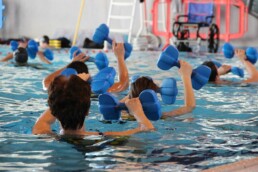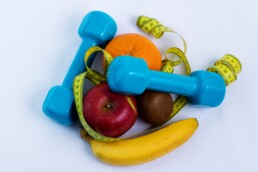Vacation Travel Doesn’t Have to Derail Your Fitness Goals
By Barbara Martinez-Benavides, First Mile Care DPP Coach
Summer is here and with most pandemic restrictions lifted, people are excited about traveling farther afield for vacation. Despite higher costs, there’s probably a driving trip on your horizon this summer and possibly a flight. Traveling is one of the best ways to break out of your routine, recharge your batteries, and create new memories (and jigsaw puzzles!) to share with friends and family — even if the travel destination is only a couple of hours away.
If you’re trying to change your lifestyle to become healthier, traveling away from home for vacation or business poses risks. Successful lifestyle change involves identifying triggers for unhealthy behaviors and developing new eating and exercise habits. Changing your routine, while a great stress reliever, also means you may sabotage those new habits you’ve been working so diligently to establish. On the plus side, travel provides the opportunity to do different types of exercise and to discover new seasonal foods and healthy brands you might not otherwise know.
A little backsliding during vacation is normal. The important thing is that if you do gain weight during vacation, that you don’t become discouraged. Instead, update your action plan, reset your goals, and continue working towards them. The First Mile Care Diabetes Prevention Program doesn’t label foods or behaviors as “good” or “bad.” What’s key is that you learn to balance your food choices and get enough activity into your daily routine to address your caloric intake to stop or reverse prediabetes.
Whether you’re going on a road trip or hunkering down in your annual vacation cabin, how can you avoid succumbing to temptation and undermining your hard-won achievements?
Location, location, location
It’s easier to control the quantity and quality of your meals if you are fixing them yourself, just as you do at home — and a lot less expensive, too. If you have the option of staying in a motel or rental home with a kitchen, you can more closely approximate the healthy meals you have at home. You can also enjoy checking out what’s available in the local markets.
But not everyone enjoys meal planning. Or perhaps your idea of vacation is to have someone else do the cooking for you? I previously wrote on how to stay on track with your eating goals when dining in restaurants — tips such as deciphering the menu, making substitutions, and rightsizing your meal.
The “highway to the Danger Zone” of fast food can be found en route to your vacation destination. Airports, train stations, and roadside diners are often the exclusive preserve of fast food, whether familiar chains or Mom ‘n’ Pop stands. But don’t despair; there are healthier choices available depending upon the type of restaurant you choose, as I recently described in an article on fast-food dining.
Jeannie Lawson is a Houston-area resident who has completed the First Mile Care Diabetes Prevention Program. “I used to not pay attention to what I ate when I traveled, so I might lose weight but then gain it back while traveling. Now I’ve developed the habit of tracking calories as a result of the First Mile Care program and continue making healthy choices even when I’m eating away from home. For example, I spent a week at a spa hotel in Mexico which has fabulous food. I’ve gone to that hotel several times over the years and have always gained at least five pounds. But after being in the First Mile Care program, even though I didn’t actively track that week, it was always in the back of my mind. I knew the choices I was making and how to reconcile them. This time I only gained one pound — which I easily lost at home.”
Respect the zzzzzz
A change in sleeping habits often accompanies a change in venue. It could be attributed to a different time zone, a strange mattress, eating late, or drinking more alcohol than normal. You may be cramming as many wakeful hours of fun as possible into your limited vacation time. It could be all these things combined!
We all know how sleep affects mood, problem solving, and memory, among other mental impacts. But there is also a strong connection between inadequate sleep and weight gain. Sleep affects two hormones, leptin — which tells your body that you’re full — and ghrelin — which tells you when you’re hungry. A restful seven hours a night is considered the minimum amount of sleep for adults. Resist the temptation when traveling to burn the candle at both ends. Instead, try to maintain good sleep hygiene to reduce the possibility of hauling home extra vacation pounds among your souvenirs.
Keep moving
An important component of the Diabetes Prevention Program (DPP) is getting regular exercise. First Mile Care recommends setting a goal of at least 150 minutes per week of physical activity in a variety of types of exercise.
If you’re doing a driving trip, you’ll obviously be doing a lot of sitting. You’ll want to make regular 10- to 15-minute stops at least every couple of hours to do some stretches and give the driver’s eyes and muscles a break. When you’re the passenger, you can do calf raises or triceps pushes while you ride.
When you’re traveling away from home for business or pleasure, you might not have access to a gym. Even if you do, spending part of your precious vacation time trapped in a tiny hotel gym is not especially appealing. Probably the easiest way to make sure you get an adequate amount of exercise while on vacation is to walk everywhere you can. It’s a great way to explore a new place or to reacquaint yourself with a place you may already know. You’ll notice more of your surroundings and may discover new shops or sights that are easily missed from a car window. You can also march in place, dance, do wall push-ups, and climb stairs instead of sitting all day.
One way to fit workouts into your travels is to bring a few packable items of exercise equipment. A flat resistance band weighs little and will fold up. A small exercise ball, when deflated, can be packed into a suitcase. If staying with friends, you can always borrow some canned food or water jugs to use as DIY weights. There are also live or on-demand streaming workouts of varying lengths that don’t require equipment that you can do through a fitness app.
And, of course, many people plan vacations specifically around physical activity despite the summer heat, taking camping, biking, and hiking trips, staying by lakes or rivers for water sports like swimming, paddling, rowing, and waterskiing, or visiting aquatic parks, amusement parks, and resorts that involve outdoor activities. And if you are staying in a resort, there could be walking tours or fun fitness classes (beach volleyball, diving, surfing, or tennis) either offered by the hotel or at a nearby facility.
Mike Kowis is a Houston-area “graduate” of the First Mile Care Diabetes Prevention Program. “Once I started the First Mile Care program, I became more mindful of my activity level. My daily steps have become such a habit that even when I was traveling out of town and checked into a hotel late at night, I went outside for a walk just before midnight to make sure I hit my daily goal. Although I tracked my calorie intake for about six months, when my wife and I took a vacation trip to Montana during the summer, I stopped tracking. I did get in a ton of walking so didn’t see any ill effects. I have found that my weight only fluctuates up or down by a couple of pounds because I am keeping up my activity level and eating the same foods. And the MyFitnessPal app for food tracking is there on my phone should I ever need it.”
Guilt-free fun
With simple tweaks, you can get in your minimum activity without feeling that you’re missing out on fun with family and friends. Walking instead of riding, swimming instead of floating, taking the stairs instead of the elevator — any movement is good movement and will help offset your well-deserved vacation meal indulgences.
Says Olidia Thomas, a Michigan resident who is currently participating in the First Mile Care program, “When I went on a vacation with friends recently, I packed healthy snacks, cooked in the resort kitchenette, and was more conscious of staying active and eating balanced meals. I found that keeping a food journal is helpful. I still eat the things I love in moderation. I just keep track of the calories and try to stay within the guidelines. Most importantly, I forgive myself when I go off course. Knowing I can fall off the wagon and get back on is important. It’s not the end of the program.”
To learn more about how you can benefit from the First Mile Care Diabetes Prevention Program, take the prediabetes risk test and get started today!
Superfoods — What’s in a Name?
By Taylor Winkel, First Mile Care DPP Coach and Registered Dietitian
The First Mile Care Diabetes Prevention Program (DPP) teaches participants to eat healthy, well-balanced meals in order to prevent long term complications associated with health problems including — but not limited to — prediabetes and hypertension.
While well-balanced meals take into account the portioning of fruit, vegetables, protein, and starches/grains, superfoods have become a popular topic in the last decade. How do superfoods fit into the DPP?
Defining the indefinable
A superfood — also known as a power food, or even as a superfruit — is a nutrient-dense food beneficial for health and well-being. The Merriam-Webster dictionary definition is “a food that is rich in compounds (such as antioxidants, fiber, or fatty acids) considered beneficial to a person’s health.”
Typically, a food is considered a superfood when it can offer maximum health benefits for minimal calories. Its benefits should go beyond what its nutritional value is, such as being linked to disease prevention. You will often see superfoods high in vitamins, minerals, antioxidants, fiber, healthy fats, phytochemicals and/or flavonoids — without high fat and sugar content. Berries are considered a superfood because they are packed with antioxidants which help fight disease and defend our cells.
For example, the current superfood du jour is quinoa, a nutrient-dense seed that has twice as much protein as brown rice. It is a “complete” protein, which means it offers all nine essential amino acids, the building blocks of protein. Quinoa is naturally gluten-free. It is low on the glycemic index, meaning it won’t spike blood sugar. It is high in manganese, copper, phosphorus, and magnesium which together provide support for your bones, collagen, blood sugar control, and sustained energy. It is also high in fiber, folate, and zinc, providing support for the digestive system as well as the brain and immune system. Moreover, quinoa has phytonutrients, providing antioxidant and anti-inflammatory benefits.
By contrast, brown rice is not a complete protein like quinoa, and it is also lower in other minerals. While it is high in manganese and fiber, it has only half as much protein as quinoa. However, brown rice is a good source of selenium which is important for thyroid and immune health. So while quinoa is considered a superfood, brown rice also contributes to a healthy diet. Variety is key to receiving a full spectrum of nutrients.
Buyer beware
Confused that there is no established minimum amount of nutrients or antioxidants in a superfood? That’s OK. Superfoods should be incorporated into a balanced menu when possible, but you don’t need to be hyper-focused on them. If you are “eating the rainbow” and choosing healthy food across all food groups, you are likely eating a healthy diet already.
Surprisingly, there are not yet official criteria or benchmarks for what constitutes a superfood in the U.S. Unlike claims such as “organic” and “healthy,” the term “superfood” is not regulated by the U.S. Food and Drug Administration (FDA) or U.S. Department of Agriculture (USDA). That means it’s basically defined by consumer food trends driven by smart company marketing. It can be what the companies and manufacturers want it to be. In fact, according to the University of California Davis, the term was first used in 1918 in the United Fruit Company’s strategy to increase banana consumption.
Therefore, when in the grocery store, you’d be wise to remember that the superfood label can be an exercise in corporate branding that often provides an excuse for a higher price — rather like the equally unregulated term “natural.” For that reason, you won’t see superfood on food labels in the European Union without a specific, authorized, associated health benefit.
Here are a few examples of popular foods that could be considered superfoods — they have passionate advocates as well as critics.
- Fruits: apples, açaí berries, avocado, bananas, blueberries, goji berries, pomegranate (including seeds), tomatoes , watermelon
- Vegetables: broccoli, Brussels sprouts, kale, seaweed, spinach, sweet potatoes
- Legumes: chickpeas, lentils, soybeans (including tofu and tempeh)
- Grains, Seeds & Nuts: buckwheat noodles, oats, quinoa, chia seeds, flax seeds, pistachios, walnuts
- Herbs: garlic; ginger; green tea; tarragon
- Animal Protein: eggs, yogurt, halibut, salmon
Though superfoods have a lot to offer and can help you reach optimal nutrition, it isn’t necessary to obsess over them. The key to achieving a healthy diet is variety and moderation, which is why First Mile Care coaches advocate well-balanced meals such as outlined in the USDA MyPlate dietary guide.
To learn more about how you can benefit from the First Mile Care Diabetes Prevention Program, take the prediabetes risk test and get started today!
Helping patients with prediabetes, one ZIP code at a time
First Mile Care, which is a health platform that is like Uber but for prediabetes, finds ways to deliver timely diabetes prevention in patients’ communities to make changes that stick. Read the full story via the American Medical Association >
Making Healthier Choices in Fast-Food Restaurants
By Barbara Martinez-Benavides, First Mile Care DPP Coach
Most people will find themselves occasionally pulling into a restaurant drive-through lane on the way home from work, or perhaps when on a road trip. The hustle and bustle of everyday life tempts us to rely on convenience. In a 2013–2016 survey, more than one-third of U.S. adults said they consumed fast food on a given day.
Recognizing this fact of life, First Mile Care Diabetes Prevention Program (DPP) coaches guide participants on how to maintain healthy eating habits when fixing a healthy meal at home isn’t possible or requires too much time. “Healthy fast food” may sound like a contradiction in terms, but that’s not the case. Even in fast-food restaurants, it’s possible to find healthier items on the menu.
Everyone has their favorite indulgences. The goal of First Mile Care is to help participants make lifestyle changes that stick for the long term, without having to deny yourself the things you love. Learning to make healthier swaps when eating out can give your body the nutrients it needs, while avoiding the things that could sidetrack your progress toward prediabetes intervention.
Planning for temptation
Have you ever sat near someone on an airplane who brought aboard McDonald’s French fries? It’s hard not to begin fantasizing about their golden crispy deliciousness, despite being aware of their levels of fat, salt, sugar, and additives.
The smell and appearance of fast food can influence you to order something you wouldn’t otherwise have considered eating. The reason for this is what we think of as “junk food” is highly processed and designed to be addictive —as well as ultra-pleasing to your taste buds and olfactory system. It lights up the pleasure centers of your brain to keep you coming back for more. This makes craving processed foods a very real thing.
The way to combat temptation is to take a few minutes to review the menu before you enter the restaurant, decide what to order, and follow through. Many restaurants list the calories, saturated fat, trans fat, sodium, carbohydrates, and other nutrients in their offerings. If you can’t find it, ask an employee for a copy of the nutritional information. If the description reads like a chemistry project, move on to something — or somewhere — else.
Here are some other tips to keep in mind when you dine in a fast-food restaurant.
- Choose wisely. Many fast-food restaurants now offer vegetables, soups, and salads — but avoid adding crackers, croutons, bread, grated cheese, bacon bits, and creamy dressings. If you load toppings, it may defeat the purpose of making the “healthier choice” in the first place. Choose plain vegetables (grilled or steamed, no butter), a baked potato instead of fried, and fruit for dessert. Make sure that toppings are on the side so you can control what, and how much, is included.
- Rethink liquids. Sweet drinks (including tea and natural drinks like lemonade) and milkshakes are calorie bombs that make it easy to swallow hundreds of calories without realizing it. Skip the sugary sodas and opt for plain water, sparkling water, infused water, unsweetened tea, or water with lemon juice.
- Don’t upsize your meal. Choose the smaller size when ordering a combo meal. Paying a few cents more to get a much larger portion may seem like a great deal, but it will add a lot of fat, calories, and sodium. And, probably, you will eat more than your hunger requires. Usually when people are served more food, they eat more, instead of eating mindfully and listening to their body’s hunger signals.
- Leave some food on the plate. You don’t have to finish everything on your plate. When you feel satisfied — but not necessarily full — you can stop eating. You might be able to get a to-go container, although fast food does not always age well.
Making meals happier
There are many options when it comes to eating at a fast-food restaurant. Here’s what to look for and what to pass up at each of the most common types of establishments.
Hamburger restaurants
Best Options: plain single grilled burger (if possible without a bun, with a lettuce wrap, no ketchup/mayonnaise), grilled chicken, veggie burger, salads (lettuce, tomato, cucumber, no cheese), extra lettuce, tomatoes and onions, baked potatoes, mustard, pickles
Limit/Avoid: extra cheese, mayonnaise, ketchup, special sauces, French fries, breaded or fried meat or fish, bacon, heavy dressings, chicken nuggets and strips, onion rings, chili, milkshakes
Fried chicken restaurants
Best Options: skinless unbreaded grilled chicken breast, salad (tomato, lettuce, cucumber), baked potato
Limit/Avoid: fried chicken, extra crispy teriyaki wings or fried chicken chunks, chicken and biscuits, Caesar salad, coleslaw, French fries, onion rings, mashed potatoes with gravy, extra sauces, ketchup
Sandwich restaurants
Best Options: lean regular or junior sized meats (such as roast beef, chicken breast, lean ham), whole grain breads, vegetables, mustard, vinegar, olive oil
Limit/Avoid: fatty meats, tuna salad, bacon, meatballs, cheese, mayonnaise, special dressings (eg. buffalo), white bread, croissants, crackers, chips, cookies
Mexican restaurants
Best Options: lean grilled meats (fajitas), fish or shrimp, vegetable burritos, vegetables, beans, corn tortilla, guacamole, salsa, pico de gallo
Limit/Avoid: crispy toppings or wraps, street corn, refried beans, sour cream, extra cheese, chips and queso
Italian restaurants
Best Options: thin crust pizza with less cheese and more vegetables, antipasti with vegetables, pasta (whole wheat if possible) with tomato sauce and vegetables, grilled lean meats, tomato-based soup, balsamic vinegar/olive oil as dressing
Limit/Avoid: thick or buttery crust pizza, meat lover’s pizza, stuffed-crust pizza, extra cheese, garlic bread, meaty antipasti, meat lasagna, caprese salad, mozzarella sticks, cream or butter-based sauces (eg. alfredo), tiramisu
Asian restaurants
Best Options: lean meat, vegetables (broiled, steamed or sautéed), edamame, cucumber salad, low-sodium soy sauce
Limit/Avoid: anything fried or crispy, tempura, fried rice, peanut sauce, sweet and sour sauce, regular soy sauce, fortune cookies, sugary drinks
Fast food is convenient, inexpensive, and tasty, but it is also packed with fats, sodium, dyes, preservatives, and sugar — all things that could raise your risk of obesity, diabetes, high blood pressure, heart disease, and stroke.
However, you don’t need to cut fast food completely out of your life. Learning to enjoy things in moderation through healthy swaps is key to lifestyle change and maintaining a healthy life balance.
To learn more about how you can benefit from the First Mile Care Diabetes Prevention Program, take the prediabetes risk test and get started today!
Q&A With DPP Participant: Changing My Relationship With Food
By Juliana Ronn, First Mile Care Director of Operations
Olidia Thomas is a 72-year-old widow who lives in Ypsilanti, Michigan, with her two youngest granddaughters. She spent 45 years as a healthcare manager at the University of Michigan in Ann Arbor before her retirement. She has been in the year-long First Mile Care Diabetes Prevention Program (DPP) for seven months.

1. Olidia, Were you concerned about prediabetes before joining the First Mile Care Diabetes Prevention Program?
Minimally. I had heard the term at my job and knew about prediabetes monitoring but didn’t really think it applied to me. Nobody ever does, right? There isn’t a history of diabetes in my family, although hypertension is common. I take medication for high blood pressure.
My physician, Dr. William Chavey of Emmaus Health Partners, did talk to me for a couple of years about my need to lose weight. He was concerned that my blood glucose put me in the prediabetes range. I have some friends who have type 2 diabetes and must take shots or pills, and I certainly didn’t want to let myself get to that point. So, when I got a letter from Coach Taylor Winkel of First Mile Care saying that Dr. Chavey had recommended me as a candidate for the diabetes prevention program, I was ready to try it.
2. Have you tried any weight loss or lifestyle change programs in the past?
Oh sure, I have paid memberships in several weight loss programs and gyms in the past. I’ve gained weight and lost it and gained it all back again. I wasn’t consistent with any of it and would get discouraged and give up. For example, Weight Watchers didn’t work for me as I had to deny myself too many of the things I really liked. I tried to game the system by starving myself just before the weigh-ins. The thing was, I was focused solely on the short-term goal of losing pounds rather than on making the long-term behavioral changes that would result in weight loss.
3. You’ve been in the First Mile Care DPP for about seven months. What results have you seen so far?
Yes, I’ve already lasted longer in First Mile Care DPP than in any other program I’ve tried. And that’s because I’ve made a firm commitment to myself to stay on course. In addition, the changes are fairly easy to make, and I can see the effects. My doctor was really impressed with my progress at my checkup.
- I feel better. I don’t feel sluggish. That’s a significant improvement for me.
- My A1C has fallen from 5.7 two years ago to 5.2. My doctor said it’s now “better than normal” and no longer in the range for prediabetes.
- I’ve lost 32 pounds so far. My long-term goal is to lose about 90 pounds, even though I may not be able to lose all that by the time I finish the First Mile Care program in the fall. Instead, I’m focusing on achieving short-term goals of 20 pounds, and then will reset my goals. My doctor says this is my lowest weight in four years.
- I can feel the change in my clothes, especially on my bottom half. My clothes feel loose and comfortable. A belt that used to be so tight I couldn’t wear it, is now loose enough that I use the second notch from the end.
4. Why do you think the First Mile Care program is working for you when others haven’t?
I have a positive mindset and commitment to the program. I follow the suggestions that my coach makes. It’s not just about denying myself food but about setting goals, looking at what I eat, counting calories, increasing water intake, increasing fruits and vegetables, looking at portion sizes, and getting more exercise.
I found that keeping a food journal and tracking my intake is helpful. It’s not onerous to do it. I still eat the things I love, like ham, in moderation. I just keep track of the calories and try to stay within the guidelines. Even when I went on a vacation with friends recently, I packed healthy snacks, cooked in the resort kitchenette, and was more conscious of staying active and eating balanced meals. Most importantly, I forgive myself when I go off course.
5. What has been the most helpful thing that you’ve learned in the First Mile Care program?
My entire relationship with food is changing. I used to eat whatever I wanted and as much as I wanted, without thinking about it. Now I eat mindfully. I look at the calorie counts, and especially at the portion sizes. I’m not only eating more fruits and vegetables; I’m adding more variety. I used to eat a lot of fast food, especially pizza, but have cut way back. My whole way of eating is changing!
6. What are some of the specific changes you have made?
Oh, there are so many!
- Portions and servings. I pay attention to portion size and eat smaller amounts. I even bought little serving trays to use for preparing my weekly meals.
- Meal prep. I am trying new ways of preparing my food and recently bought an air fryer. For example, I love fried chicken but now put it on the grill or the air fryer instead of traditional frying. I fixed some sweet potato fries in the air fryer, and they were delicious! Now I’m trying to get used to the taste of olive oil as I know it’s healthier.
- Shopping. I plan my week’s meals before I go to the store so that I don’t buy things on impulse that aren’t healthy. I avoid buying soda pop and other things, like candy, that I know I’ll find hard to resist if I have them in the house.
- Nighttime snacking. I’m a night owl and sometimes snack late at night, but now I eat carrots and celery at Coach Taylor’s suggestion.
- Restaurant dining. I’m of the generation that doesn’t believe in wasting food. At my coach’s suggestion, I now always ask for a to-go container at the start of the meal and put half my food away. I can still eat at my favorite Olive Garden but split my serving into two meals.
- Exercise. I was never consistent at exercise, but now I always meet or exceed the recommended minimum of 150 minutes of weekly moderate exercise. I follow YouTube exercise videos for seniors, bought resistance bands for at-home strength training, and just got a FitBit to track my steps and blood pressure.
7. What role has your coach played in your success?
Coach Taylor is very motivating and encouraging – a real cheerleader when it comes to keeping everyone in the group on track towards their goals. When someone falls off the wagon, so to speak, she encourages us to get on again. She has made suggestions that I hadn’t thought of before, like doing short sprints of exercise during TV commercials. I have stopped watching TV in bed so that it’s easier to get up and move about. She’s made me aware that every little bit of movement counts towards my activity goal.
8. First Mile Care emphasizes neighborhood-based groups that pull participants from the same ZIP codes. How has being in a group helped you?
The group is helpful both in terms of accountability and motivation. You want to be able to tell people each week about your progress and get bragging rights and congratulations. But it’s also helpful to swap stories about our struggles. I feel less discouraged if I know that other people also fall behind in meeting their goals, yet can get back on track.
We also share tips and recipes and information on where to go shopping. For example, one of the women in my group suggested juicing, so now I make that into my own tea. I never used to like tea but am trying it as a substitute for soda pop, so my granddaughter and I have boiled apple, lemon, and pineapple peels for tea.
9. How do you expect to maintain the progress you have made in changing your lifestyle?
This is the longest I’ve stuck with a lifestyle change program. Knowing I can fall off the wagon and get back on is important. It’s not the end of the world. It’s not the end of the program. I plan to keep monitoring what I eat, setting up meal plans, eating more vegetables, drinking more water, and getting my minimum 150 minutes a week of exercise. One recommendation in the program is to get your family members involved so that they can support you. I’ve got my grandchildren to remind me that “you said you weren’t going to eat that.” If I ask my granddaughter to buy me a candy bar now, she won’t!
10. What advice do you have for people who join a lifestyle intervention program like First Mile Care?
You have to be committed. You have to make up your mind that you really want to follow the program, but also recognize that there will be times that you may not be able to stick to it. Set your goals in increments so that you can achieve small successes as you work towards them. Allow yourself to backslide at times. The important thing is that you don’t give up! It’s worth the effort. The finish line is attainable.
To learn more about how you can benefit from the First Mile Care Diabetes Prevention Program, take the prediabetes risk test and get started today!
Aquatic Fitness Is More Than Just Swimming
By Shavon LeBlanc, First Mile Care DPP Coach
Summer is almost upon us so everybody jump into the pool! Aquatic fitness is an optimal form of exercise; a hidden jewel that is often overlooked. The pressure and resistance of water provide a soothing environment that engages your entire body in building strength and flexibility.
Why is water a great exercise option? It torches calories! You can burn more calories in an hour-long, high-intensity aquatic class than on the treadmill. Whether you are experiencing joint pain, rehabbing an injury, are pregnant, deconditioned, overweight, or even an athlete — water exercise is an all-inclusive workout that is adaptable to all fitness levels and provides a true fitness challenge.
As part of the First Mile Care Diabetes Prevention Program, coaches encourage participants to engage in a minimum of 150 minutes of moderate physical activity every week to lower the risk of developing type 2 diabetes and other chronic illnesses and diseases. Aquatic classes and swimming are examples of moderate physical exercise that may help participants in reaching the DPP goal of losing 5-7% of starting weight.
Land versus water
When working out on land, there are compound exercises which can target multiple muscle groups at the same time. For example, a squat-to-press movement engages your lower body, core, and upper body within one exercise.
When working out in the pool, your entire body is targeted, providing a full body workout within one class session. One of the greatest benefits to water-based exercise is that it targets the primary muscles as well as their opposing muscle group. For example, when running in the water, you are getting the benefit of the force of the water targeting both the hamstrings and the quadriceps. When pushing up within the pool, you benefit from targeting the chest muscles, back muscles, and core.
The buoyancy of water provides the freedom to participate in exercises like squatting and jumping that can be challenging outside of water. This buoyancy also provides the opportunity to increase the intensity of exercise without causing joint pain. Normally, when lifting weights on land, there is a teardown of muscle to build stronger muscle. But the resistance offered by water accomplishes muscle toning without creating joint tension. The force of the water targets your abdominal muscles and builds flexibility, balance, strength, and endurance — all while reducing stress on your joints.
Here are some examples of water-based exercises:
- Swimming Laps: freestyle, backstroke, breaststroke, butterfly stroke
- Water walking: walking in patterns, backwards walking, side-to-side walking, single leg balance walking
- Water running or jogging: water racing, time-based running sequence, wall running, backwards running
- Water aerobics: integrates exercises such as basketball, bicep curls, boxing, dancing, jumping, lunging, squats, and cross-country skiing
Some people also find they can exercise longer in the pool than on land, due to the cooling effect of water on body temperature.
What you’ll need
Your pool probably provides major gear like water bicycles, treadmills, and elliptical machines. There are several smaller items that you may want to supply yourself if they aren’t otherwise available, such as:
- Buoyancy belt to assist in floating
- Foam dumbbells or strap-on wrist or ankle water weights for building resistance
- Resistance gloves or hand paddles for strength training
- Kickboard
- Fins
- Goggles or eye mask
However, please don’t use household items like empty water jugs as aqua weights, as they are ineffective and unsafe in the pool.
Developing a routine
When putting together your your aquatic fitness routine, keep in mind the FITT principle:
- Frequency: 3-5 days per week
- Intensity: Moderate to Very Intense
- Time: 30-45 minutes
- Type: swimming laps, aqua stretching, aquatic running or jogging, aqua bicycling, aqua boxing, aquatic boot camp, Aqua Zumba©
For example, First Mile Care participant Katherine Dowling swims laps for up to 30 minutes at her local YMCA twice a week, at the recommendation of her cardiologist. She says, “It’s wonderful to be in the water. Swimming is like a vacation or therapy, as it’s so peaceful and relaxing, and you can think about whatever you want to think about.”
Aquatic fitness can be enjoyed by everyone. Jump right in; the water’s fine!
To learn more about how you can benefit from the First Mile Care Diabetes Prevention Program, take the prediabetes risk test and get started today!
Time to step up screening for prediabetes and type 2 diabetes
“And the Diabetes Prevention Program from First Mile Care, a Health2047 spinoff, provides coaching, support and other resources enabling people to live longer and healthier lives.”
Read the full article via the American Medical Association.
Letting Nutrition Labels Guide Your Grocery Shopping
By Kathy Gregory, First Mile Care DPP Coach
Learning to make more nutritious choices in the foods and drinks you consume is key to adopting a healthy lifestyle. As part of the Diabetes Prevention Program (DPP) curriculum, First Mile Care coaches teach participants how to track their intake and become more aware of portion size and the high calorie and highly processed foods to limit. The goal is to increase awareness of how eating smaller portions of higher quality foods as part of a balanced diet can satisfy hunger and improve wellness.
When navigating the grocery store, examine packaging carefully before you decide on a purchase. Generally, the statements on the front of a package are marketing claims, while the back or side has factual information. By checking the nutrition facts label, you can make more informed choices. If you’re trying to lose weight, you’ll be mindful of how many calories you eat, and how many are from sugar and fat. If you have high blood pressure, you’ll look at salt content. It may take a bit longer to do your shopping, but when you pull an item from the cupboard at home, you’ll know it was the best option available.
First Mile Care participant Jeannie Lawson was shocked at the high calorie and fat content listed on labels. “It has made me very conscious of what I put in my mouth and has changed how I do my grocery shopping. Now when I am in the store, I use a smartphone app called Lose It!, which reads the barcode and tells me the label information. It helps me with tracking what I consume and deciding if I really want to buy that food item with high calorie or carbohydrate or salt count.”
Servings versus portions
For anyone seeking to monitor their calorie intake or consumption of different proteins and vitamins, the serving sizes listed on nutrition labels can guide you in the right direction. All the nutrient amounts on the label are based on the serving size. The serving size reflects a standard quantity chosen for measurement and is not a specific recommendation of how much you should consume of the item.
It’s easy to misread and misinterpret nutritional labels, and they are not infallibly exact. As per the FDA guidelines, “FDA’s continuing policy since the 1970s assigns the manufacturer the responsibility for assuring the validity of a product label’s stated nutrient values.” What’s more, the average size of some food items, especially produce, is larger today than when the standard serving measurements were developed years ago. Bananas, for example, come from mini to giant sized, and chicken breasts are larger than they used to be.
What can be confusing is that while a serving is what is stated on the package, it may not be the amount that you would normally eat of a particular item — what’s called a portion. Therefore, it’s critical to look at the number of servings in the package. It’s OK to eat more than a serving, as long as you are aware that you are also consuming multiples of calories and nutrients, too.
For example, according to the packaging on a Top Ramen brick of noodles, a serving is just half the brick, even though most people will consume the entire brick as their portion. The label on a can of soup or chili or clam chowder, or a packaged Indian dinner, or boxed pasta, may also say it’s multiple servings, even though the actual quantity that will satisfy you is the entire package.
If you eat two servings, you need to double all the quantities in the nutrition facts. So if a serving has 150 calories but you ate two servings, you actually ate 300 calories. For example, the nutrition label on a package of rice says that a serving is half a cup, but most people would consume more than that amount in a single sitting. If your portion is one cup of rice, that is two of your recommended servings of grains for the day.
Another food item whose serving size is easily misunderstood is breakfast cereal. Most people just eyeball the amount of corn flakes or granola poured into a bowl. If you read the serving size listed on the label, you may find you’re eating double or even triple the serving — as well as the sugar and calories.
The confusion doesn’t end with food. Some beverages, like Gatorade and some brands of kombucha, contain more than one serving in a single small can or bottle.
Achieving balance
Calories provide a measure of how much energy you get from a serving of a food item, and the number of servings you eat determines the number of calories you consume. Balancing the number of calories you eat and drink with the number of calories your body burns through daily activity is a stepping stone to achieving a healthy body weight. Your estimated calorie needs may be higher or lower and vary depending on your age, sex, height, weight, and physical activity level.
As First Mile Care participant Al Cisneros explains, “I never used to look at food labels or packaging. When my wife asked me to pick up bread and butter at the grocery store, I grabbed the first thing I saw. I never considered basing my choices on sodium and fat and carbohydrate levels. My First Mile Care DPP coach, Sandra Huskey, encouraged us to read labels carefully, track calories in our food journals or apps, and make wise decisions based on whether an item is really worth how long it will take to burn off the calories.”
Labels also show how much a nutrient in a single serving contributes to the percentage of Daily Value (%DV) reference amount of nutrients to consume (or not to exceed) in a recommended daily diet. You can use the %DV figure to gauge how a food’s nutrients stack up and which nutrients to consume more, and which to consume less.
Five ingredients or less
Nutrition labels sometimes seem written in a foreign language. The rule of thumb for labels on healthier food items is five ingredients or less, if possible. You want to see words that you recognize as ingredients instead of the names of dyes, fillers, preservatives, and chemicals. Whole foods like produce, legumes, lean meat, eggs, whole grains, nuts, and seeds generally have fewer ingredients so there’s less uncertainty about what you’re putting in your mouth.
Some nutrients are better in smaller amounts. Many ultra-processed packaged foods include added fat, sugar, salt, and preservatives. Eating too much fat, especially saturated fat or trans fat, cholesterol, added sugars, or sodium can raise your risk of health problems such as heart disease and high blood pressure. On the flip side, there are nutrients such as fiber, vitamins, and minerals that can improve your health and lower your risk of certain health problems. Most Americans don’t get enough dietary fiber, vitamin A, vitamin C, calcium, or iron.
Nutrition labels caused First Mile Care participant Jeff Millhouse to re-evaluate the multi-day juice cleanses he used to do on a regular basis to help maintain his weight. “When I looked at the labels on several of the juices, I was surprised at the added sugar. This occurred with both the juice cleanse bundles and a healthy juice I bought at a local vegetarian restaurant. I’ve also changed the type of yogurt I buy, and look more closely at the sugars in cereals and packaged products.”
Knowledge is power
The First Mile Care Diabetes Prevention Program is centered on developing sustainable healthy changes to diet and fitness, without giving up the foods you enjoy.
Nutrition labels pack a lot of useful information into a tiny box. They can guide you to become a smarter grocery shopper (and eater). As First Mile Care participant Katherine Dowling advises, “Whoever is doing the grocery shopping should be studying that, especially if you’re buying something that is pre-made. It’s a way to keep yourself on the straight and narrow.”
To learn more about how you can benefit from the First Mile Care Diabetes Prevention Program, take the prediabetes risk test and get started today!
Returning to Restaurant Dining
By Barbara Martinez Benavides, First Mile Care DPP Coach
As the pandemic continues to recede, many people are excited to find themselves eating more often in restaurants. However, eating away from home can present a challenge if you are making lifestyle changes to stave off or reverse a prediabetes diagnosis. It requires some thought and planning to eat healthily when you prepare your own food, let alone when someone else does it.
In the First Mile Care Diabetes Prevention Program (DPP), coaches counsel participants on how to create and sustain healthy eating habits when away from home, whether dining at a friend’s house or in a restaurant. The challenges you may encounter in restaurants include:
- Tempting food
- No healthy choices
- Not knowing ingredients or how food was made
- Oversized portions
- Wanting to get your money’s worth
- Not wanting to make a fuss by asking questions
However, you can stay on track with your eating goals in restaurants without a lot of effort if you just do a little planning before you go, and ask a few questions once you’re there. It can be as easy as ordering a turkey sandwich with a side salad instead of a hamburger and French fries, or drinking sparkling water instead of soda.
Choosing the restaurant
Restaurants often serve highly processed foods that are high in calories, saturated fat, and salt. In general, you are more likely to find healthy choices at sit-down restaurants, places with a salad bar, vegetarian restaurants, and restaurants offering a cuisine that has many vegetable dishes even if they’re not strictly vegetarian (e.g., Chinese, Ethiopian, Indian, Japanese, Korean, Malaysian, Thai, Vietnamese, etc.). You are less likely to find healthy choices at all-you-can-eat buffets, pizza parlors, burger joints, and most fast-food restaurants. However, there’s usually at least one decent option, and there might be a salad bar.
In order to choose both a restaurant and a meal wisely, it’s a good idea to look at the menu in advance. That will give you more time to think about possible swaps and questions to ask, rather than feeling put on the spot when the waitress approaches you or you reach the counter.
As First Mile Care participant Roberta Varnado explains, ‘I learned a trick for when I go out to eat. My coach, Robert McNeill, explained that most restaurants will have their menus posted to their websites with nutritional information on calories, carbs, sugar, sodium, etc. I didn’t realize that it was possible to find that information so easily, so you can plan your meal in advance and be sure to choose the healthier options.”
With a little advance planning, you can drop into restaurants to pick up menus in-person, or develop the habit of taking photos of menus that look promising. If you save the photos into a folder on your smartphone, you can peruse them at your leisure. Then, when the opportunity to dine out arises, you’ll know which restaurants to suggest.
Deciphering the menu
Once you have the menu in front of you, look for dishes that are low in calories, fat, and sugar; high in fiber and water; and high in vitamins, minerals, and protein. There are some key terms on the menu that suggest an item is a healthier choice. These include adjectives such as diet, light, low-fat and fat-free, along with ingredients such as vegetable oil, whole grain and whole wheat. In addition, look for words that indicate how the food is prepared, such as baked, broiled, grilled, and steamed.
Making substitutions
Once you’re in the restaurant, don’t feel shy about asking questions of the wait staff. They’re usually happy to help you make the best choices so you’re satisfied with your meal — and will tip well! To find out if an item is healthy, you could ask how it’s made, the ingredients in the dish, and the type of oil used to cook it.
It also never hurts to ask for a healthy swap, even if options aren’t listed on the menu. Many servers are willing to order a swap if you ask politely, or if you pay a small substitution fee. Here are some common healthy swaps that restaurants will often accommodate:
- asking to have an item baked, broiled, grilled, or steamed instead of fried
- requesting an item be cooked in vegetable oil instead of lard or butter
- asking for fat to be trimmed from meat, or skin removed from chicken — before it’s cooked
- getting a healthy side dish of salad or steamed vegetables instead of French fries
- swapping zucchini noodles or spaghetti squash for pasta
- substituting cauliflower rice for regular rice
- putting butter, dressing, gravy, sauce, and sour cream on the side
- substituting fruit for other desserts
Don’t overlook the healthy aspect of the beverage you order; water with lemon, sparkling water, or unsweetened ice tea are better drink choices than sugar-laden sodas. You can usually get skim milk for coffee instead of half-and-half, too.
Rightsizing your meal
In addition to finding out if an item is healthy, you’ll also want to make sure you have the right amount of food. Many restaurants serve huge portions, or you may want to try just a small amount of a delicious-sounding item that is high in calories. Appetizers and desserts, especially, are often designed to be shared (and their prices reflect this).
Many people were raised to feel they have to clean their plates, and consequently feel guilty about wasting money if they leave food behind. First Mile Care participant Regina Hasan avoids the temptation to overeat by requesting that half her restaurant meal be put into a takeout container. She does this when she places the order, rather than waiting to the end of the meal.
To make sure you have a healthy amount of food, you could ask:
- for a smaller portion (or even order from the kids’ menu)
- to have an appetizer as your main course
- to share items with your meal companion
- to get a to-go box when you first order your meal
Restaurant dining offers entertainment as well as nourishment. It’s wonderful once again to feel comfortable and safe eating out in a busy place with friends and family. And with a little research into menu ingredients, preparation style, and portion size, you can savor every bite and enjoy a meal out that is as healthy as one at home. The goal of First Mile Care DPP is to help participants create realistic eating habits that intervene with prediabetes, without giving up the food you love or skipping on things you enjoy.
To learn more about how you can benefit from the First Mile Care Diabetes Prevention Program, take the prediabetes risk test and get started today!
Strength Training Tips for Beginners
By Shavon LeBlanc, First Mile Care DPP Coach
“A little step may be the beginning of a great journey.”
— Author unknown, probably from a Chinese proverb
At the start of a new year, gyms are filled with people who are excited to start their fitness journey and create healthy habits. Adopting a new fitness regimen can be both. Every day is an opportunity to begin afresh.
In the beginning, cardiovascular exercise is the primary focus, whether in the gym or at home. Walking, jogging, swimming, and dancing are fun ways to build your cardiovascular endurance while increasing your heart rate. The goal is to progress to building muscle through strength and resistance training.
- Strength training is building strength through the body’s response to force applied by heavy resistance weight on bones, joints, muscles, and connective systems.
- Resistance training uses your body weight, free weights, resistance bands, and machines to help build lean muscle through lower impact movements.
Strength training provides many benefits, as it can result in decreased body fat and increased coordination, power, and metabolism. It helps the pre-menopausal mom build strong bones and muscle, the active older adult prevent chronic illness, the grandfather improve balance and coordination, and the bodybuilder change body composition.
Research studies have demonstrated the link between strength training and improving insulin sensitivity, thereby improving control of blood sugar. In the First Mile Care Diabetes Prevention Program (DPP), we encourage participants to include strength training as a part of their regular workout plan. Lifting weights consistently can help participants reach and exceed the First Mile Care program goals of moderate physical activity of at least 150 minutes per week and losing 5-7% of starting weight.
Kicking off your strength training
When lifting weights, there are multiple strategies to consider. Determining your fitness goals will define the amount of weight you should lift, how often, the number of repetitions, and when to increase weight. The important thing to remember is that lifting weights is part of a well-rounded training program.
One example workout plan includes lifting lighter weights with higher repetitions, as well as lifting heavier weights with lower repetitions. There are programs that include lifting major and opposing muscle groups back-to-back in what is called a superset.
When beginning to lift weights, please consider the following questions:
- Am I training to build muscular endurance?
- Am I training to build muscle strength?
- Am I training to increase muscle size?
There are five essential movements to practice when building a strength training program: pushing, pulling, hinging, squatting, and core. When first starting out, weight lifting machines are helpful to build general understanding of which muscles are associated with each movement. For example, use a leg press machine for a squatting movement, a shoulder press machine for a pushing movement, a lat pulldown machine for a pulling movement, a kettlebell swing for a hip hinge movement, and planks for core movement.
Here is a sample beginner workout:
- Squats: 3 sets of 12 repetitions beginning with 10-15 lbs or no weight at all
- Lunges: 3 sets of 12 repetitions beginning with 8-10 lbs or no weight at all
- Deadlifts: 4 sets of 10 repetitions with 10 lbs or more
- Bicep Curls: 3 sets of 8 repetitions with 1-10 lbs or more
- Step Ups: 3 sets on each leg using 8-12 lbs or no weight at all
- Plank: 5 repetitions for 20 seconds each
- Push Ups: 3 sets of 8-10 repetitions
Listen to your body
Know your limits and abilities and build a firm foundation by starting slowly and using dynamic movements to build mobility and flexibility. Examples of dynamic warmup moves include side lunges, windmills, and walking knee holds that can prepare your body to lift, as well as lowering injury risk.
Pay close attention to any warning signs from your body and never exercise to the point of pain. How to lift a weight — the best form — is more important than lifting a heavy weight improperly, which can increase injury risk. When beginning your weight lifting journey, enlist guidance from a fitness professional (or your First Mile Care DPP coach) to teach you how to properly execute an exercise to lower injury risk.
Our bodies are filled with 60-70% of water so adequate hydration before and during strength training are vital. When dehydrated, the body cannot perform optimally due to lower blood volume. On average, women and men should consume more than 10 cups of water daily and add an additional 8-16 ounces when exercising. An electrolyte drink can be helpful during strength training sessions to replenish both water and carbohydrates.
Rest is an overlooked component in building strength. Between strength training sessions, recovery is vital to maximize muscle growth and strength, and to prevent overtraining or straining a muscle. Extended time periods of soreness past 48-72 hours can be a sign of overtraining. It is important to stretch and recover both before and after your workout to support recovery, prevent injury, and prepare the body for future lifts.
Slow and steady for sustainable change
The strongest home is built with time, attention, focus, and consistency. Your body is your house. Resistance training can be helpful in building a strong house from the inside out.
Strength training is about building strength progressively — learning movements, performing and practicing them repeatedly, and incrementally increasing the resistance through weight lifted. Keep these things in mind:
- Aim to build your strength progressively over time.
- Reject the idea of reaching your goal in a short period, which can lead to unhealthy habits such as overtraining, and not adequately refueling your body.
- Avoid trying to measure your progress with what you see on social media.
- Be patient with yourself, learn as you grow, get help, and maintain consistency.
Remember that strength training is a journey. Build a firm foundation, make rest and recovery a priority, take in adequate hydration, fuel your body with ample amounts of protein, and enjoy every step of building strength, one workout at a time.
To learn more about how you can benefit from the First Mile Care Diabetes Prevention Program, take the prediabetes risk test and get started today!















